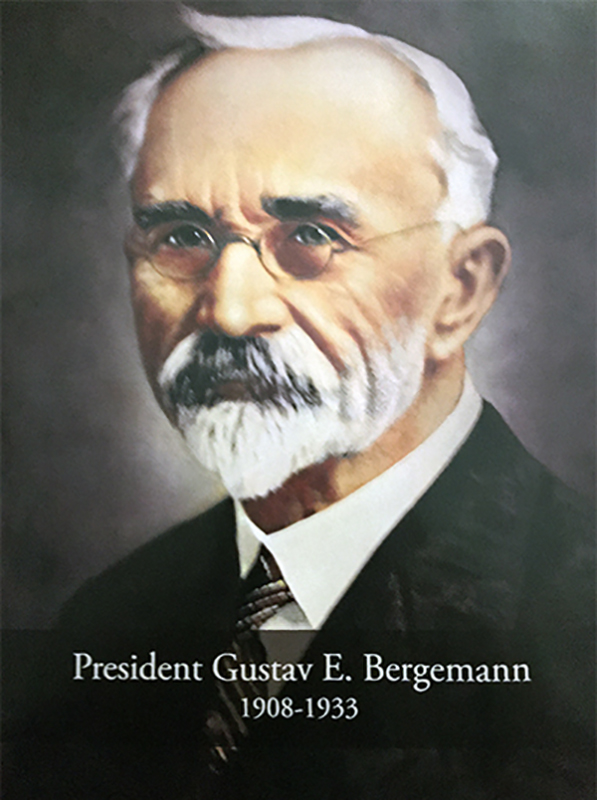1908-1933 President Gustav E. Bergemann
 Gustave Ernst Bergemann
Gustave Ernst Bergemann
was born August 9, 1862, to Ludwig Bergemann and Wilhemine nee Schulz of Hustisford, Wisconsin. After being instructed and confirmed by Pastor Philip Koehler, he entered Northwestern College on November 14, 1879. In 1885, he graduated alongside Ott, Weimar, Knuth, and Brandt as a member of what he termed “the model class.” After three years at the Eimermann’s Park seminary, he received an early assignment to Bay City, Michigan and was installed as pastor on June 26, 1887. On October 31 of the same year, he married Emma Anger of Watertown, Wisconsin. His health led him to accept a call to Tomah, Wisconsin in October of 1892. From Tomah, he also took charge of stations in Lincoln, Knapp, Goodyear, and Babcock. By late 1899 he had received and accepted a call to St. Peter’s in Fond du Lac, Wisconsin, where he was installed on December 10.
While pastor there, Bergemann would continue to render additional service to the growing synod. In addition to the serving the Board of Trustees, the Board of Northwestern College, the federated synod’s boards for the seminary, teacher’s college, and Indian and Lithuanian missions, he was elected first vice president of the Wisconsin Synod in 1907.
Bergemann’s term as vice president was short-lived. 1908 signaled a shift in the leadership of the synod. The synod suffered the loss of not only its foremost dogmatician and professor, Dr. Adolph Hoenecke, but also the resignation of Johannes Bading, the longtime confessional compass of the synod. At the same time, President Philip von Rohr became ill and would not survive the year. For Bergemann, this meant that already in January he would function as acting president, and by December he would be leading the synod as its new president.
As the federated synods approached the 400th anniversary of the Lutheran Reformation, their leadership recognized that a new structure could increase opportunities for publication, worker training, and missions. Gustave Bergemann was influential in the transition from federated synods to a merged synod.
Edward C. Fredrich writes:
“Muehlhaueser founded the Wisconsin Synod. Bading shaped its confessional stance. Bergemann gave it its organizational form. Bergemann made the merger and then made it work.”
The work paid off: by 1920, the synod was unified under one administration and carried out its work among eight districts. Bergemann’s influence extended well beyond the organization of synods and districts. He was ultimately responsible for the doctrine and practice of the synod under his charge. Challenges appeared in both respects.
In the early 1920’s, strains of rugged individualism seemed to resist the newly established structures of synod and seminary alike. The formation of the Protest’ant Conference in late 1926 was the most noteworthy, but by no means unique, controversy of Bergemann’s presidency. At the same time, sentiment was growing against a rising financial debt within in the synod. The national economic disaster of 1929 and the Great Depression which followed further injured the synod and its leadership.
By summer of 1933, these unfortunate events had combined to produce a poor sentiment within the Wisconsin Synod towards their president. When elections were held at the August convention, the delegates opted to elect John W.O. Brenner, a pastor who had taken over Bading’s pulpit and who had himself become notable for his leadership on the committees for seminary construction and synodical debt retirement.
Following the 1933 convention, Bergemann continued to serve the Winnebago Conference as visitor and returned to his pastoral duties at St. Peter’s until his retirement in 1947. Gustav was preceded in death by his wife Emma and by his two sons, Hans and Edward. Edward Arthur had died at the age of four months and was buried in Bay City. Hans had died in 1918 at the age of 25. Mrs. Bergemann died September 6, 1945. Gustav E. Bergemann died May 13, 1954. At the time of his death, he was survived by two daughters and three grand-children.
Gustave E. Bergemann may be remembered as a president who guided the Wisconsin synod through challenge and controversy, a president who stood for re-election and lost. Such a memory would certainly be incomplete. Again Fredrich:
He deserves better. Bergemann was an able administrator at a time when the church body needed that gift as never before or since in its history. Even more important, his ministry and his administration, his theology and preaching were thoroughly gospel oriented and permeated. Those who worked with him and those who learned from him agree that this commitment to the gospel was the driving force in this synodical leader.
From 1908 until 1933, Bergemann safeguarded the Synod’s doctrinal integrity, fostered its administrative structure, and charted its course through difficult financial straits. Bergemann holds a unique place among Synod presidents, being the only incumbent to be defeated in an election. To his credit however, Bergemann was twice given the honor of the presidency: elected in August 1909 “by his own right” as president of the Evangelisch-Lutherischen Synode von Wisconsin, u.a. St., and again in August 1919 as president of the Allgemeine Evangelisch-Lutherischen Synode von Wisconsin, Minnesota, Michigan, u.a. St.
For Further Reading:
- Robert J. Gurgel, “G.E. Bergemann: An Evangelical Approach to the Ministry,” Wisconsin Lutheran Seminary Essay File (http://hdl.handle.net/123456789/1933).
- Armin Engel, “The Bergemann Era — 1908-1933,” Wisconsin Lutheran Seminary Essay File (http://hdl.handle.net/123456789/1356).
- “The Presidential Papers of Gustave E. Bergemann,” Wisconsin Lutheran Synod Archives Collection (Collection: The Presidential Papers of Gustave E. Bergemann).
